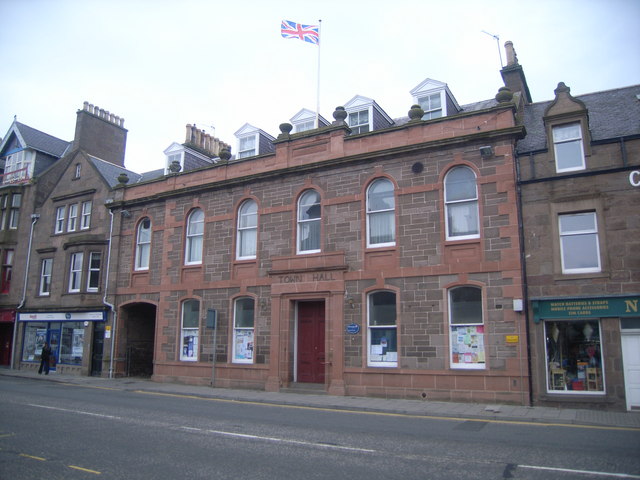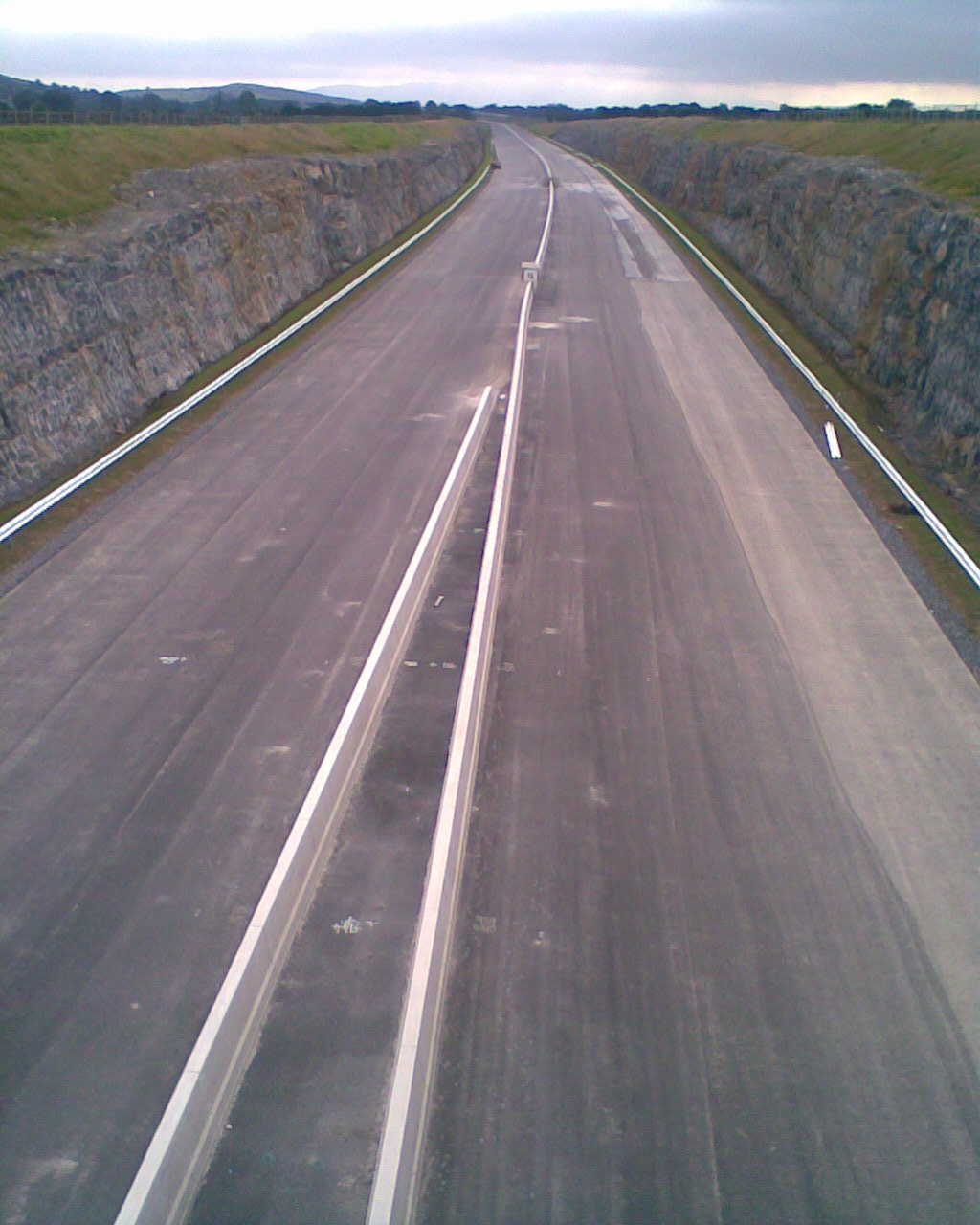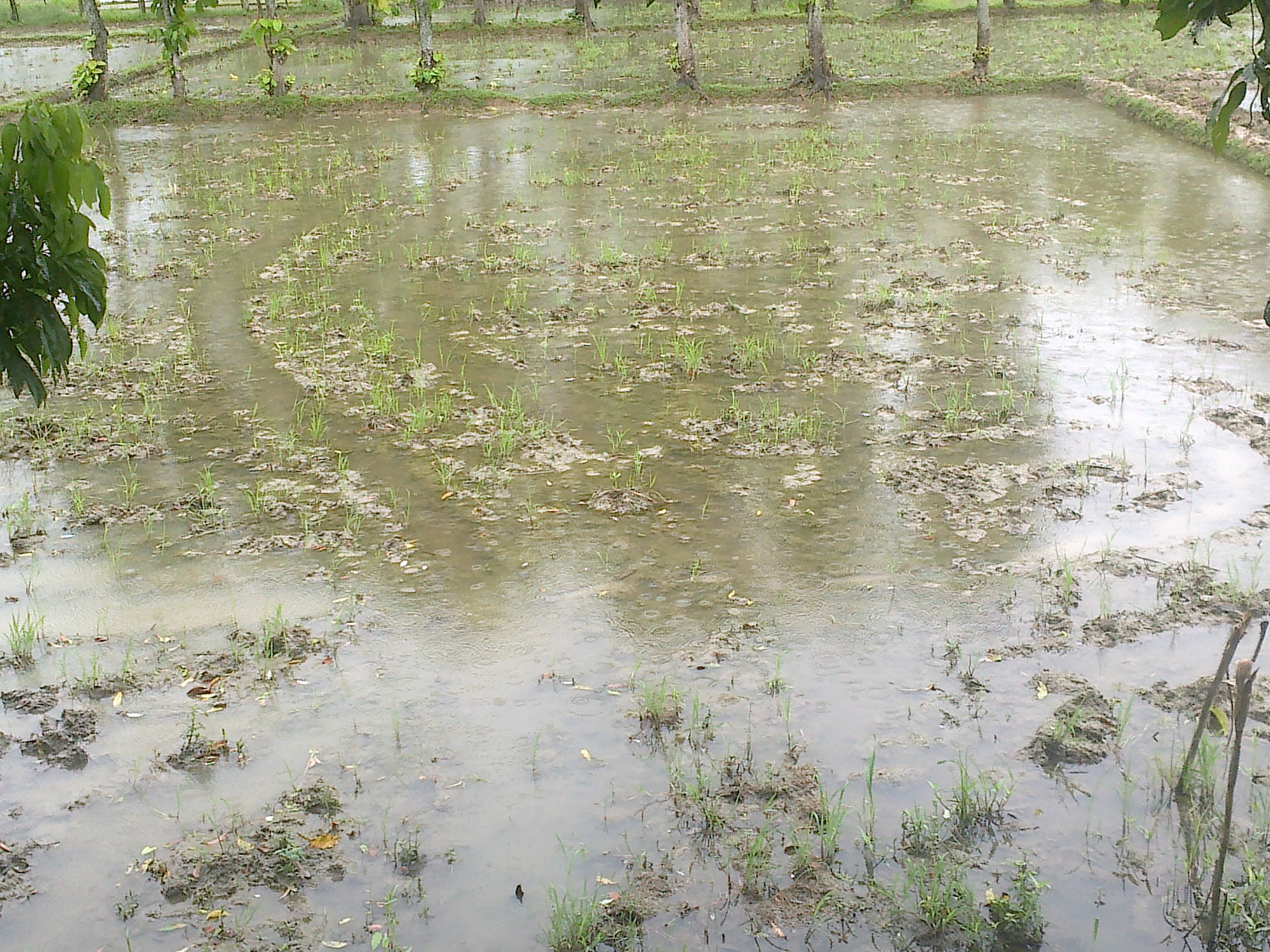|
Aberdeen Bypass
The Aberdeen Western Peripheral Route (AWPR), unofficially also the City of Aberdeen Bypass, is a major road that wraps around the city of Aberdeen, Scotland. The road stretches north from Stonehaven through Kincardineshire and crosses both the River Dee and River Don before terminating at Blackdog. The main stretch of the AWPR is in length. The AWPR also includes the A956 spur that links the bypass to the A92. The construction of the AWPR was coupled with extensive upgrades to the A90 continuing north with the Balmedie to Tipperty dual carriageway, supplanting the existing road which was subsequently detrunked and is now the B977. The AWPR's primary route is designated as part of the A90, with the original A90 now renamed the A92, which now connects with the AWPR at both of its ends. The road is predominantly rural, crossing mainly through farmland and forest while skimming past built-up areas. The AWPR is legally classed as a special road by the Scottish Governmen ... [...More Info...] [...Related Items...] OR: [Wikipedia] [Google] [Baidu] |
Stonehaven
Stonehaven ( , ) is a town in Scotland. It lies on Scotland's northeast coast and had a population of 11,602 at the 2011 Census. After the demise of the town of Kincardine, which was gradually abandoned after the destruction of its royal castle in the Wars of Independence, the Scottish Parliament made Stonehaven the successor county town of Kincardineshire. It is currently administered as part of the unitary authority of Aberdeenshire. Stonehaven had grown around an Iron Age fishing village, now the "Auld Toon" ("old town"), and expanded inland from the seaside. As late as the 16th century, old maps indicate the town was called ''Stonehyve'', ''Stonehive'', Timothy Pont also adding the alternative ''Duniness''. It is known informally to locals as ''Stoney''. Pre-history and archaeology Stonehaven is the site of prehistoric events evidenced by finds at Fetteresso Castle and Neolithic pottery excavations from the Spurryhillock area. In 2004, archaeological work by CFA ... [...More Info...] [...Related Items...] OR: [Wikipedia] [Google] [Baidu] |
A92 Road
The A92 is a major road that runs through Fife, Dundee, Angus, Aberdeenshire, and Aberdeen City in Scotland. From south to north, it runs from Dunfermline to Blackdog, just north of Aberdeen. History The A92's original route in southern Fife is now numbered as the A921. It connects with the M90 junction 1 via Burntisland and Kirkcaldy and links into the Thornton bypass. Plans were drawn up in the 1960s for a new East Fife regional dual carriageway road starting at the M90 at Masterton (Junction 2), which would have mirrored what is now the A921 and B9157 to the Mossgreen area, before heading north-eastward to Chapel Level, connecting up with the Thornton By-pass. The plans were held back until the early 1970s, and were held back further due to the Oil crisis. During the 1970s the Scottish Development Department commissioned a new traffic study which concluded that the A92 should follow the more northern route to provide a better link for Cowdenbeath and Lochgelly before c ... [...More Info...] [...Related Items...] OR: [Wikipedia] [Google] [Baidu] |
Mastrick
Mastrick ( gd, Mastraig) is an area of Aberdeen, Scotland, located on the western fringes of the city around 2.5 miles from the city centre. It currently has a population of 7,365 and an unemployment rate of 1.6%. Residential property in the area is a mix of houses and flats, 23% of which are still council owned. This is around twice the average in Aberdeen City. Mastrick has several shops and is within a short walking distance of Hazlehead Park, Northfield, Sheddocksley, Summerhill and Woodend. Woodend Hospital is a short distance away from Mastrick, as is the hospital complex at Foresterhill Foresterhill is an area in the city of Aberdeen, Scotland. It is the site of the city's main hospitals ( Aberdeen Royal Infirmary, the Royal Aberdeen Children's Hospital and the Aberdeen Maternity Hospital), as well as the medical school and m .... The boundary of Mastrick was George Handsley's house. The local football team is Northstar Community football Club With Ages Under 15 ... [...More Info...] [...Related Items...] OR: [Wikipedia] [Google] [Baidu] |
Northfield, Aberdeen
Northfield is an area of Aberdeen, Scotland. It has a community council, swimming pool, medical practice and a police office. The Aberdeen Treasure Hub art gallery in the area was opened in November 2016. Education There are four primary schools: Westpark School, Bramble Brae School, Heathryburn School and Manor Park School. Secondary age pupils go to Northfield Academy. Swimming pool Northfield Swimming Pool is a council-owned facility with a 25-metre pool. It was opened in 1996. It closed in March 2019 due to an equipment failure. Later that year, the council announced that the pool would be refurbished and expanded, and would reopen in summer 2021. However, due to the COVID-19 pandemic, the reopening was postponed to summer 2022. References Areas of Aberdeen {{Aberdeen-geo-stub ... [...More Info...] [...Related Items...] OR: [Wikipedia] [Google] [Baidu] |
Hard Shoulder
A shoulder, hard shoulder (British) or breakdown lane, is an emergency stopping lane by the verge of a road or motorway, on the right side in countries which drive on the right, and on the left side in countries which drive on the left. Many wider (U.S.) freeways, or expressways elsewhere have shoulders on both sides of each directional carriageway — in the median, as well as at the outer edges of the road, for additional safety. Shoulders are not intended for use by through traffic, although there are exceptions. Purpose Shoulders have multiple uses, including: * Emergency vehicles such as ambulances, fire trucks and police cars may use the shoulder to bypass traffic congestion. * In the event of an emergency or breakdown, a motorist can pull into the shoulder to get out of the flow of traffic and obtain a greater degree of safety. * Active traffic management, used on busy multi-lane roads, may allow 'hard shoulder running' by general traffic at reduced speeds during per ... [...More Info...] [...Related Items...] OR: [Wikipedia] [Google] [Baidu] |
Concrete Step Barrier
A concrete step barrier is a safety barrier used on the central reservation of motorways and dual carriageways as an alternative to the standard steel crash barrier. United Kingdom With effect from January 2005 and based primarily on safety grounds, the UK National Highways policy is that all new motorway schemes are to use high-containment concrete barriers in the central reserve. All existing motorways will introduce concrete barriers into the central reserve as part of ongoing upgrades and through replacement when these systems have reached the end of their useful life. This change of policy applies only to barriers in the central reserve of high-speed roads and not to verge-side barriers. Other routes will continue to use steel barriers. Government policy ensures that all future crash barriers in the UK will be made of concrete unless there are overriding circumstances. Ireland The usage of the concrete step barrier has become widespread in Ireland. As of 2017, of moto ... [...More Info...] [...Related Items...] OR: [Wikipedia] [Google] [Baidu] |
Slip Lane
A slip lane, also known as a filter lane in the United Kingdom, is a road at a junction that allows motorists to change roads without actually entering an intersection. Some intersections that are controlled by lights offer a slip lane, which allows cars to bypass the lights when they turn. That helps ease congestion and improves journey times, as people turning do not have to stop at the light but can continue at the same speed. There are two types of slip lanes at intersections: slip lanes that end and require traffic to merge to join the main road and slip roads that continue onto the main road as another traffic lane. Rules In Australia, before entering a slip road, drivers must look to ensure that their blind spots are clear of other motorists, cyclists, and pedestrians. Drivers must then give way to any pedestrians crossing the slip road. Before joining the main road from a slip road, drivers must give way to all other traffic even if it is faced with a give-way or with ... [...More Info...] [...Related Items...] OR: [Wikipedia] [Google] [Baidu] |
Grade Separation
In civil engineering (more specifically highway engineering), grade separation is a method of aligning a junction of two or more surface transport axes at different heights (grades) so that they will not disrupt the traffic flow on other transit routes when they cross each other. The composition of such transport axes does not have to be uniform; it can consist of a mixture of roads, footpaths, railways, canals, or airport runways. Bridges (or overpasses, also called flyovers), tunnels (or underpasses), or a combination of both can be built at a junction to achieve the needed grade separation. In North America, a grade-separated junction may be referred to as a ''grade separation'' or as an '' interchange'' – in contrast with an '' intersection'', '' at-grade'', a '' diamond crossing'' or a ''level crossing'', which are not grade-separated. Effects Advantages Roads with grade separation generally allow traffic to move freely, with fewer interruptions, and at higher over ... [...More Info...] [...Related Items...] OR: [Wikipedia] [Google] [Baidu] |
Special Road
A special road is a road or highway (these terms have different meaning in different jurisdictions in the UK) in the United Kingdom reserved for use by ''special'' classes of traffic; such roads include but are not limited to motorways. For a road to designated a special road, the status must in England and Wales be provided by a scheme under the Highways Act 1980; in Scotland Special Roads are provided for in the Roads (Scotland) Act 1984; in Northern Ireland, legislation commenced with the Special Roads Act (Northern Ireland) 1963. The Special Roads Act 1949 The passing of the Special Roads Act 1949 through Parliament allowed authorities in Great Britain to construct roads that were not automatically rights of way for certain types of user. Existing roads were mostly rights of way for all road users, including pedestrians, so it was not possible to build roads designated only for motorised traffic. The Act therefore allowed the construction of motorways. The Special Roads Ac ... [...More Info...] [...Related Items...] OR: [Wikipedia] [Google] [Baidu] |
Forest
A forest is an area of land dominated by trees. Hundreds of definitions of forest are used throughout the world, incorporating factors such as tree density, tree height, land use, legal standing, and ecological function. The United Nations' Food and Agriculture Organization (FAO) defines a forest as, "Land spanning more than 0.5 hectares with trees higher than 5 meters and a canopy cover of more than 10 percent, or trees able to reach these thresholds ''in situ''. It does not include land that is predominantly under agricultural or urban use." Using this definition, '' Global Forest Resources Assessment 2020'' (FRA 2020) found that forests covered , or approximately 31 percent of the world's land area in 2020. Forests are the predominant terrestrial ecosystem of Earth, and are found around the globe. More than half of the world's forests are found in only five countries (Brazil, Canada, China, Russia, and the United States). The largest share of forests (45 percent) are in ... [...More Info...] [...Related Items...] OR: [Wikipedia] [Google] [Baidu] |
Farmland
Agricultural land is typically land ''devoted to'' agriculture, the systematic and controlled use of other forms of lifeparticularly the rearing of livestock and production of cropsto produce food for humans. It is generally synonymous with both farmland or cropland, as well as pasture or rangeland. The United Nations Food and Agriculture Organization (FAO) and others following its definitions, however, also use ''agricultural land'' or as a term of art, where it means the collection of: * ''arable land'' (also known as ''cropland''): here redefined to refer to land producing crops requiring annual replanting or fallowland or pasture used for such crops within any five-year period * '' permanent cropland'': land producing crops which do not require annual replanting * ''permanent pastures'': natural or artificial grasslands and shrublands able to be used for grazing livestock This sense of "agricultural land" thus includes a great deal of land not devoted to agricultural use. T ... [...More Info...] [...Related Items...] OR: [Wikipedia] [Google] [Baidu] |



.jpg)



